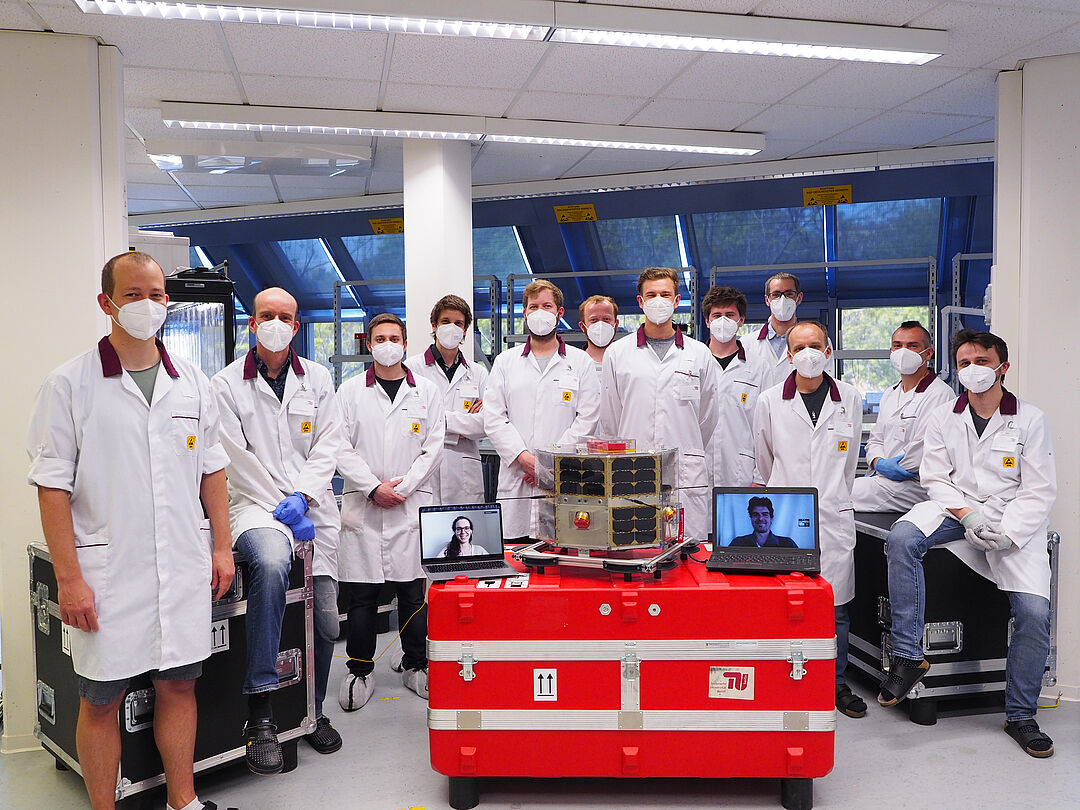Goal is to identify forest fires
TU Berlin's TUBIN microsatellite was launched Wednesday evening (30.06.21) at 21:31 CEST from Cape Canaveral with a Falcon-9 rocket built by SpaceX. Its mission is to monitor large fires such as forest fires. The control center on Campus Charlottenburg has now received the first signals sent by the satellite.
The ground control stations in Antarctica and on the roof of Building F at TU Berlin have confirmation: The 22.5-kilogram TUBIN microsatellite, measuring about 31 x 47 x 47 centimeters, successfully initialized after detaching from the rocket's upper stage and is sending signals to Earth from its orbit at an altitude of 530 kilometers. The satellite is carrying two infrared cameras on board as well as a third imager with sensitivity in the visible spectrum.
"Following the successful launch, we are now focusing on Earth remote sensing," explains Julian Bartholomäus, payload engineer and project leader. The researchers want to find out whether so-called microbolometers could also be used as sensors for satellites to detect forest fires. Microbolometers are used, for example, in commercially available thermal imaging cameras and detect long-wave infrared light. However, only sensors which are sensitive to short-wave infrared light have been used in large satellites until now. Forest fires radiate about ten to one hundred times brighter in this wavelength range than in long-wave infrared. The challenge is that these sensors require complex cooling and thus are not suitable for small satellites.
You can view a video of the TUBIN launch here: Space-X-Website (Mission: Transporter-2 Mission).
Every point on Earth can be observed
 © Merlin Barschke
© Merlin Barschke
"Microsatellites in fact offer several advantages," says Bartholomäus. They are affordable and can be used for niche applications. Their low cost also allows entire fleets to be deployed: With 12 satellites in three orbital planes, every relevant point on Earth could be observed within 24 hours. However, TUBIN alone actually flies over the entire Earth, because the planet rotates under its orbit. "Nevertheless, it takes about nine days until we can observe the same area again," continues Bartholomäus. By then, many forest fires could already be extinguished.
Increased danger of forest fires due to climate change
In many regions of the world, climate change is causing longer periods of forest fires as well as a greater number of such fires. In addition to annual large vegetation fires in Southwest Australia and the Western USA, European countries such as Germany are increasingly threatened by large fires. The TUBIN mission will now monitor European forest fires more closely.
Every pixel of the thermal camera on board represents a temperature-dependent electric resistance. One pixel corresponds to an area of 150 x 150 square meters on the Earth's surface. Under ideal conditions though, fires of a smaller size can also be detected. With a resolution of 40 x 40 square meters per pixel, an optical camera supports the infrared cameras while special additional algorithms are used to better understand the recorded images and identify clouds and water in addition to fire. The researchers are also investigating whether fires can be better detected when the algorithms are adapted to different regions of the world.
In addition to the infrared cameras, TUBIN also has an innovative radio transceiver on board developed in Germany (under the project name XLink IOD). The transceiver allows TUBIN to send the image data collected ten times faster to ground control at the Chair of Space Technology.
Culmination of satellite research at TU Berlin
Sixteen research associates contributed to the construction of the TUBIN satellite. In 2017, a predecessor satellite, TechnoSat, was launched, testing the small satellite platform in space for the first time and laying the foundation for TUBIN. TUBIN is also referred to as TUBSAT-27 in recognition of TU Berlin's long commitment and involvement in the development of small satellites. "The successful launch of the 27th satellite is a wonderful gift for our upcoming anniversary," explained Professor Enrico Stoll, head of the academic chair. Nearly 30 years ago, on 17 July 1991, the first TU Berlin satellite was launched with an Ariane-4 rocket. "This makes TU Berlin one of the of the world's leading universities in this field," continues Stoll. Unfortunately, TUBIN's orbital lifetime is limited - in about five to six years, it will have slowed down due to friction in the atmosphere and will burn up in the lower layers of the air.

 © Philip von Keiser
© Philip von Keiser